How Staff Scheduling Software Can Save Time & Money for Your Business

October 24, 2023

Running any type of hospitality business like a bar, restaurant, or brewery is a challenging ordeal.
With so many moving parts — ordering supplies, creating menus, and the overall operations, managers barely have enough time to make sure things are getting done.
Then, there’s creating a schedule to ensure you have staff on hand to run everything smoothly.
Primitive methods of writing schedules by hand, or even “advanced” ways of putting them together with a computerized spreadsheet, can tack on hours to a manager’s week and, more importantly, take them away from more critical tasks.
Scheduling software tools, like North Carolina-based Schedulefly, have swooped in to solve that issue, saving companies time and money while streamlining operations.
We heard from Schedulefly Co-Founder Wil Brawley, Mad Mole Brewing Taproom and Operations Manager Byron McSweeney, and Big Red F Restaurant Group Owner and Chef Dave Query, who explain how using scheduling software is a win-win for brewery operations—and many other hospitality services—big and small.
What We’ll Cover in This Piece:
What Is Staff Scheduling Software?
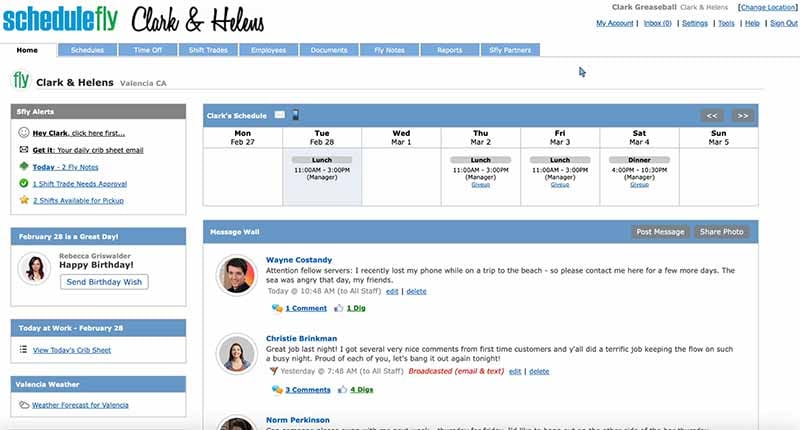
Schedulefly started in 2007 and has grown the business to six thousand customers, including roughly three hundred breweries—primarily through word of mouth.
So what is staff scheduling software, and why would thousands of businesses sign up for it?
“It’s a simple restaurant employee schedule subscription software,” Brawley says.
The Schedulefly team noticed how restaurant and brewery managers would create a weekly staff schedule, spending numerous hours piecing together the puzzle of fitting staff into hours while meeting a budget, only to have it change immediately, then needing to reassemble everything.
“[Managers] used to write a schedule for hours on a Sunday and print and post it, and as soon as [they] did, there were changes, people wanting time off [leading to] lots of phone calls, inefficiencies, or people looking at the schedule wrong,” Brawley explains. “The idea [for Schedulefly] was to provide a web-based way to manage the schedule and for the staff to know when they work and who they are working with, all from their phone.”
How Does Staff Scheduling Software Work?

Once the manager sets the schedule on a staff scheduling software, the tool gets to work.
“Employees can offer up shifts, and a text and email goes out to other staff about the shift,” Brawley says. “The manager can approve or deny that shift based on several variables. When the manager approves or declines the request, the schedule is updated automatically.”
McSweeney says Mad Mole has a small staff of about six for the brewery, which has just one location but is open seven days a week.
“We mostly use Schedulefly just for the schedule aspect, and then the requesting time off is used by the staff fairly frequently,” he says. “I keep people on a consistent schedule. I can go in, and I can schedule two months out and post it so people know when they are needed, and if they need time covered, they can do that with plenty of time.”
On the flip side, Big Red F has seven locations, including a brewpub, The Post Chicken & Beer, which all vary in size but average around seventy or so employees, according to Query.
He says they use Schedulefly—going on fourteen years now—to plug in the schedule and budget the staff accordingly.
“For our use and needs, Schedulefly has been the simplest to use,” Query says, adding that they used old-school handwritten schedules before linking up with Brawley’s company.
McSweeney says using staff scheduling software makes it easy to monitor their budget. He says the only time he has a holdup is when some of his staff goes out of town, and they might need to factor in overtime. But all-in-all, he says it’s minor.
“Schedulefly is so user-friendly,” he says. “Once you sign onto it and spend an hour, you know what it’s all about.”
Query echoes McSweeney’s sentiment.
“A manager builds parameters to prevent havoc being created by employees behind the manager’s back,” Query says. “And allows Employee A to message Employee B and ask to be covered.”
He adds, “This saves the manager time and the employee does the work to get the shift covered.”
Query explains that the system sends a message to the manager, and all they have to do is approve or deny.
What Are the Benefits of Staff Scheduling Software?
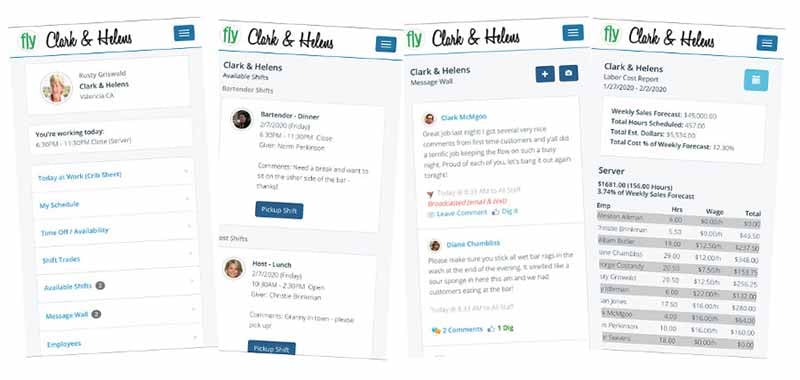
According to Brawley, communication is more streamlined, making that a top benefit of the service.
“Without something like Schedulefly, the employee calls the manager, and then the manager has to make calls,” Brawley explains. “There are a lot more efficiencies and a lot less missed shifts.”
He adds, “Schedule and communication is what Schedulefly is all about.”
Brawley also says the ease of use—for both managers and the staff alike—leads to attracting and keeping talented people on staff.
“Staffs are looking for this to make their lives easier,” Brawley says, noting that his service syncs with a person’s preferred smartphone calendar. “There are so many scheduling software [options], ours and others. The challenge is, unless you have an experienced staff, you’re at a disadvantage hiring and keeping people. In this market, tools like this make it easier for you. This makes the staff’s lives easier.”
McSweeney says the company used hand-written schedules before the six-year-old Mad Mole signed up for Schedulefly four years ago.
“It’s much easier and much more accessible now,” he says. “It was a headache and was stressful before.”
McSweeney adds, “I can make a three-to-ten shift on Schedulefly and put people on the shift on a certain day. It’s easy and accessible to do that on my part. For the bartenders, it’s easy for them to look at the schedule, and they’ll be there.”
Query’s big selling point is the employee’s flexibility and control of what’s going on with the schedule, in addition to taking an unwanted burden from a manager.
“The biggest thing about Schedulefly is the ability for employees to live their life and have total freedom,” Query opines. “It’s a great management tool. It puts the onus on the employee to get a shift covered and takes something off the manager’s several things to do.”
He adds, “It’s easy for employees to use, communications with employees and managers have been easy, the platform is easy to send company-wide or individual location announcements, it’s very easy to onboard, and it’s a great way to communicate with employees.”
A hidden benefit of the service is that it just works. Meaning the site is always up and running, and rarely, if ever, is there a glitch.
“I’ve never had any issues with Schedulefly as far as the site being shut down or not being able to pull it up,” McSweeney says. “It’s very reliable. Very rarely, if at all, do I need customer service. And if I do, it’s solved within minutes.”
Brawley, who answers most the toll-free calls for customer service for Schedulefly, backs McSweeney's claims with cold, hard facts about its thousands of customers.
“We kept the software simple and easy to use and only get about five calls and thirty emails a day,” Brawley explains. “It’s point, click, and go. But when they need something, they get an immediate response.”
How Much Time and Money Does Staff Scheduling Software Save?
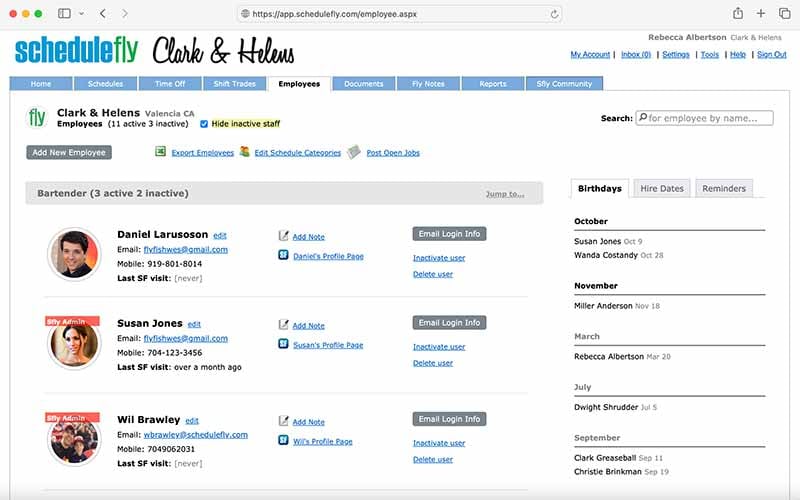
Brawley said Schedulefly doesn’t track any data on how much time and money his service saves customers but said they have one way of telling whether it’s effective.
“We prefer to just say, ‘We got a thirty-day free trial; see for yourself how much time and money you save,’” Brawley says. “Most people realize those savings through the free trial and become customers.”
McSweeney couldn’t pinpoint a number on how much money the staff schedule service saved Mad Mole but says the service has “absolutely” saved time.
“I’ve been in the industry twenty-five years. Schedulefly takes one or two hours out of a day versus a day or two handwriting,” McSweeney says. “It was always verifying, verifying, verifying. And even if I assume a shift was covered, it would come back with a bunch of people saying they can’t work the shift. Requesting time off on Schedulefly is so easy; they do it months in advance.”
Query says they haven’t quantified that figure but is confident of its savings.
“We’ve saved tons of hours over fourteen years,” he says. “And we definitely have saved tens and tens of thousands of dollars over the years by not over-scheduling or under-scheduling. It’s easy to budget.”
What Size Staff Should You Have to Need Scheduling Software?
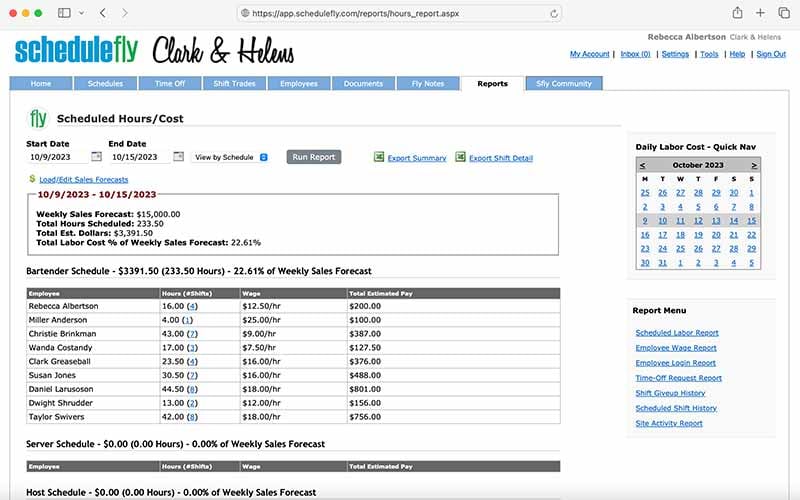
McSweeney’s staff is pretty small, but he says even as low as six to eight people is where he would start looking into purchasing a service like Schedulefly.
“The more your staff grows, it would be more beneficial to get it,” he says. “The service industry as a whole will benefit from it.”
Query says this service can work well for a staff of ten to one hundred. But more importantly, no matter the size, it brings something intangible that old scheduling methods don’t.
“Just to have a virtual schedule where a company shows they value work-life balance [is what matters, not the staff size],” Query says. “You can post a schedule a month or two months in advance.”
What Does Staff Scheduling Software Cost?
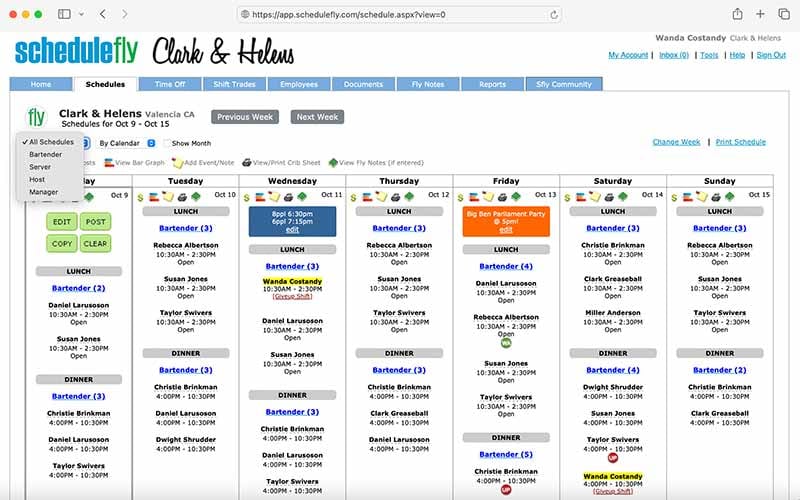
The cost of these software services, Schedulefly included, ranges based on the number of staff members you have. Brawley says their prices are incredibly competitive with the rest of the industry, with their customers paying an average of about thirty-seven dollars a month—as low as twenty dollars and upwards of a couple hundred dollars based on the size of the staff.
“We have not changed our cost in the sixteen years since we opened,” he says. “That’s been a big thing for our customers, and we’ve had customers that long.”
McSweeney says you don’t have to budget a whole lot. And when you factor in the time and money you save in the long run, it’s a no-brainer.
“It’s definitely worth the price you pay for it,” he says.
As a long-term customer at Schedulefly, Query said it’s the cheapest schedule service offered, and frankly, he doesn’t understand why they haven’t changed the cost of their product.
“It’s stupidly inexpensive. We pay $35 to $45 a month depending on the location, and we pay $500 for all our locations,” Query says. “I don’t know of anything we buy that’s cheaper. We spend more on cups, beer cups, etc.”
He adds, “Everything is more expensive than these huge scheduling tools.”
Schedulefly also does not require contracts, nor do they have setup, training, or cancellation fees, Brawley says.
“We don’t pretend to be big corporate,” Brawley says. “We’re just a group of five guys who love what we do. That message resonates with breweries.”
Let's Upgrade Your Business
Looking for staff scheduling software? Visit Schedulefly today to start your free trial!
Need to build amazing digital and print menus to share with millions of craft beer enthusiasts? Get started with Untappd For Business!
